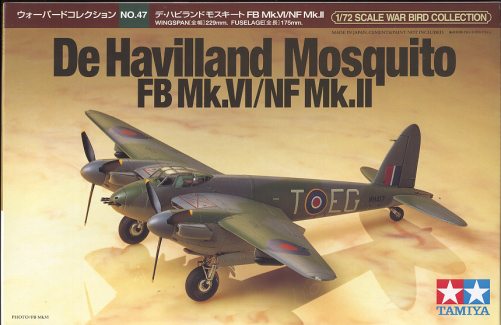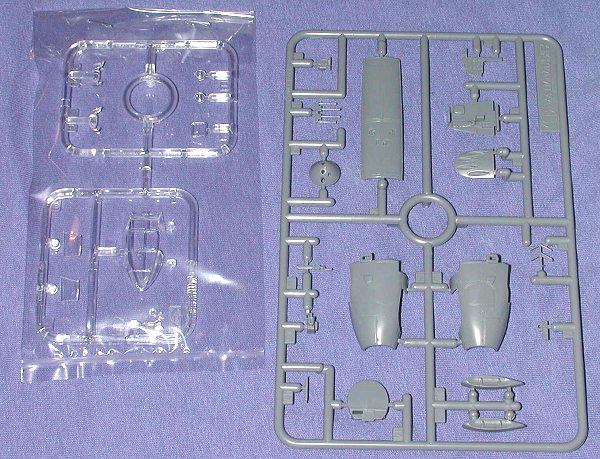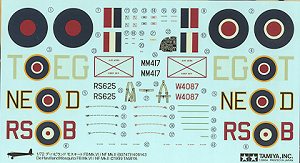
|
KIT: |
Tamiya 1/72 Mosquito FB.VI/NF.II |
|
KIT # |
60747 |
|
PRICE: |
$23.00 |
|
DECALS: |
Three Aircraft |
|
REVIEWER: |
|
|
NOTES: |

|
HISTORY |
The Mosquito was one of those fortuitous designs that happen just at the right moment. The British needed a fast light bomber that would make major use of non-strategic materials (wood) and save the aluminum for other things. The end result was one of the most useful aircraft produced by the British during the war. Though initially developed as a bomber, it was eventually modified to a number of other useful types. This particular boxing is for the early fighter variants, specifically the NF.II night fighter and FB.VI fighter-bomber. Actually it didn't do the jabo mission as was done in the USAAF and Luftwaffe, but more of an intruder mission that included bombing of strategic targets rather than tactical bombing. It was as a night fighter that it was initially most successful. It was able to carry the bulky early radar sets and its good speed meant that it could actually catch some of the prey it found. However, it was the fighter-bomber variant that was probably where it found its greatest success. Able to carry a decent bomb load and armed with 4 20mm cannon and 4 .303 machine guns, it was devastating against ground targets. Not only would it bomb the target, but then return to liberally saturate the area with lead from its guns. Post-war, the FB.VI was the type most often exported. However, its greatest strength, the wooden construction, was also its Achilles heel and the lack of ability to withstand high heat/humidity areas and the general lack of longevity of wooden planes means that few of them survived to be in museums today when compared to other types.
|
THE KIT |

In most respects it is identical to the Mosquito B.IV kit previewed a while back. To make the FB.VI or NF.II, a pair of new sprues have been included. One is the canopy as the fighter version had a flat windscreen in place of the vee shaped one in the bomber. The other is for a new nose section and bomb bay as well as a few other bits that are peculiar to the version kitted. As with the B.IV kit, there are parts that are not going to be used on this variant so you can add those to the spares box for use on other kits that may need the parts.
Early in construction one has to decide which variant and what options one will be using. The FB.VI can be built with bombs or rockets under the wings. While if doing the NF.II, other items must have holes opened or left closed. There are also prop and wing tip options, again depending on which decal version is being done, so if using aftermarket decals, one needs to do one's research prior to construction. A very nice touch is that there are wing spars included in the kit so that proper attachment and alignment of the wings will be a breeze.
 Instructions
are superb, again but for that irritating lack of proper color information. Why
Tamiya doesn't give the proper colors instead of those miserable mixing ratios
is beyond me. Surely they must know that not everyone uses or has access to
Tamiya paint. Anyway, there are three decal options. The lone NF.II from 157 Sq
is in overall matte black so that one isn't a problem to paint. No mixing
required on this one. The other two options are FB.VIs. One is with bombs under
the wings and that one is from 487 Sq. It is in Dark Green/Ocean Grey over
Medium Sea Grey. The other is a later FB.VI from 143 Sq with paddle blade props
and rockets under the wings. It is in the later Dark Sea Grey over what is
called 'deck tan' in the instructions. This sounds quite suspect and I'd be
willing to bet it is actually supposed to be Medium Sea Grey. The decals
themselves are well done and look to be quite good. Again, use setting solutions
at your own risk.
Instructions
are superb, again but for that irritating lack of proper color information. Why
Tamiya doesn't give the proper colors instead of those miserable mixing ratios
is beyond me. Surely they must know that not everyone uses or has access to
Tamiya paint. Anyway, there are three decal options. The lone NF.II from 157 Sq
is in overall matte black so that one isn't a problem to paint. No mixing
required on this one. The other two options are FB.VIs. One is with bombs under
the wings and that one is from 487 Sq. It is in Dark Green/Ocean Grey over
Medium Sea Grey. The other is a later FB.VI from 143 Sq with paddle blade props
and rockets under the wings. It is in the later Dark Sea Grey over what is
called 'deck tan' in the instructions. This sounds quite suspect and I'd be
willing to bet it is actually supposed to be Medium Sea Grey. The decals
themselves are well done and look to be quite good. Again, use setting solutions
at your own risk.
|
CONCLUSIONS |
As popular as the Mossie is outside the US, I'm sure this kit sells well there. Here in the US you can barely give away a 1/72 Mossie, and that's a shame as it looks like a great kit.
If you would like your product reviewed fairly and quickly by a site that has well over 175,000 visitors a month, please contact me or see other details in the Note to Contributors.